May 3, 2017
The ESV Lutheran Study Bible
Review by Larry J. Walker
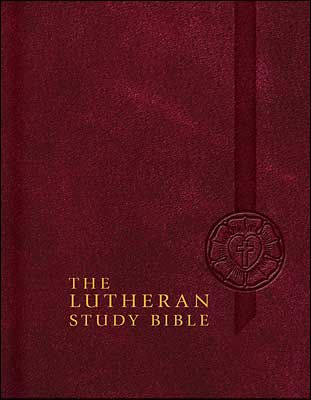
For many years the NIV Study Bible was my resource for personal Bible study. I found it a valuable aid. I never acquired the Lutheran version, the Concordia Self-Study Bible, so I had to make allowances for the Baptist-oriented theology of the notes.
In 2003 Concordia Publishing House set about producing an entirely new study Bible, based on the more literal English Standard Version translation. Lutheran scholars from various church groups and countries participated, and hundreds of laypeople provided critical feedback. The result (published in 2009) is an impressive and desirable resource which has become my regular study Bible.
At 2,372 pages and almost four pounds, this may not be the Bible you want to carry to church with you (unless you get the electronic version). It’s handsomely bound in red and printed on thin “Bible” paper. Older readers should be cautioned that the typeface is rather small.
To call the notes generous would be an understatement. They feature insights from noted Lutheran scholars, as well as citations from Luther and other Reformers, and even prayers at the ends of sections. Extras include a reading and study guide, the full text of Luther’s Small Catechism, and other helps, charts, and maps. Each book of the Bible is prefaced by an introduction (including a timeline and a section of commentary by Luther) and an outline. The editors have included special interpretive pages at strategic points where further illumination would be helpful to the reader. There is also a very good concordance at the back of the volume. A nice amenity is the illustrations, handsome nineteenth century engravings by the Lutheran artist Julius Schnorr von Carlsfeld.
In terms of 1 Corinthians 3:2 where the apostle Paul says, “I fed you with milk, not solid food,” the ESV Lutheran Study Bible is a solid food resource. If you’re looking for breezy, cheerful, inspirational material to start your day, this is not it. This is a Bible for the Lutheran who wants to study Scripture seriously, getting a sense of the original text, and understanding how the Lutheran church interprets it in light of its confessions. In the AFLC, where we emphasize informed lay leadership in the congregation, the ESV Lutheran Study Bible can be a highly valuable resource. It’s as good as a one-volume commentary.
Larry J. Walker
AFLC Schools Librarian
Plymouth, MN
The Lutheran Study Bible is available in a variety of editions. The one used in this review is the hardcover volume.
Order your copy here: Ambassador Publications Online Store
Other Editions Available:
The Lutheran Study Bible Hardcover edition is also available in large print, and with a thumbed index.
May 10, 2017
Brand Luther: 1517, Printing, and Making of the Reformation
Review by Pr. Wade Mobley
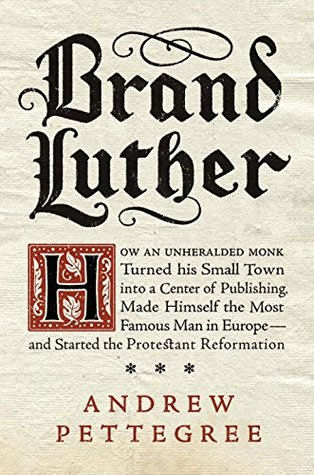
Next fall is the 500th anniversary of something called the Reformation—on that much all agree. The nature of that event, though, is more debated.
Some historians characterize the Reformation as a social rebellion of the people over the papacy, or simplistically, as the religious arm of the Renaissance. Philosophers with a similar worldview to those historians teach the Reformation as a change in the manner of human thought, perhaps even as a precursor of the European Enlightenment two centuries hence. True, the Protestant Reformation in Germany produced subsidiary benefits such as an increase in literacy and the normalization of German as a language, but the Reformation was much more than a cultural upheaval. More accurately, the Reformation was a multi-nation event that changed theology’s source (placing the Bible in people’s hands) and its content (replacing an overly optimistic view of human nature with the substitutionary atonement of Christ).
Calling the Reformation an event is even more central to the problem. Such a cataclysmic shift in both thinking and power—and in both state and church—cannot be the effect of a single event. Yet there is an event associated with the beginning of the Reformation, and that event is etched in our minds iconically: Martin Luther, hammer in hand, on the steps of the Castle Church in Wittenberg, Saxony, on All Saints Eve in 1517. That this event happened is less important to the legacy of the Reformation than what followed. That this event is etched in our mind affirms the legacy of what author Andrew Pettegree calls “Brand Luther: How an unheralded monk turned his small town into a center of publishing, made himself the most famous man in Europe—and started the Protestant Reformation.”
Pettegree tells the story of Luther and his influence against the backdrop of another one of the author’s loves: The history of printing. The advent of movable type printing presses has long been credited with hastening the influence of Reformation thinking. What has not been explored as much is the influence of the Reformation on the printing industry itself.
Printing was a sapling in the forest of business. Paper was expensive and in short supply. Ink was hard to come by, and as easy to tax and restrict as the paper itself. Printing presses, due to their scarcity alone, were easy to regulate. Not many people knew how to read. The Reformation was about to change both the printing of literature and the literacy of its consumers.
The Reformation brought a steady stream of business to presses longing for saleable material. This stream flowed from both sides of the Reformation debate, with enough populism and vitriol to turn printed paper into hard currency. Printers, who did not pay for the rights to print material, competed with one another for the opportunity to print the most lucrative content. This competition, in turn, produced printing products of increasing quality.
While Wittenberg was a small town with an even smaller printing industry, years of investments by the elector of the region, Frederick the Wise, led to the establishment of a university, and thus, a university press. Pettegree demonstrates the advance in printing from the rudimentary sheets produced by Wittenberg printer Rhau-Grunenberg to more sophisticated works of his competitors. Local artist and businessman Lucas Cranach contributed to the success of the Reformation with his funding of the Wittenberg print works and through the production of his shop that produced woodcuts for use in the printing process.
Those woodcuts are a big reason for the enduring mental pictures of the Reformation. There was a “look” to the Reformation that people saw widely distributed in print. Luther and his allies produced content that appealed to people. Though foes would follow, the visual appeal of the Reformers’ works was quite unlike the dry, academic disputations of the day. It was effective enough that their Roman Catholic counterparts considered it dirty pool. For the first time in history, the mass media would become a significant part of the message.
One question that most students of the Reformation ask is, “Why him? Why then? Why there?” There are answers to all three. God used circumstances, both political and economic to cause theological benefit. Yes, Luther was an amazing man. But he was not alone. God also used others, including a small group of publishers across Germany who had mixed motives, to spread the message of salvation in Christ alone, by grace alone, and through faith alone. God, in His sovereignty, made Luther and the Reformation, but God used printing as one of His tools to do so. And in some respects, God, Luther, and the Reformation expedited the printing industry.
Pettegree provides the reader with a strenuously-researched, brilliantly-written volume that is a delight to read. The author’s point includes the benefit of aesthetics, and he models this in a way that will not disappoint. Ample pictures and maps illustrate the pages, helping those with limited geographical knowledge of Europe. The fusion of two interests—Luther and printing—is not forced, and allows the author passionate expression of his material. With a wealth of Luther reading either in print or in the offing, Brand Luther deserves a place near the front of the line.
Pr. Wade Mobley
President of AFLC Schools and Dean of AFLTS
Plymouth, MN
This review was originally published at www.anselmhouse.org
Order your copy here: Ambassador Publications Online Store
Also Available:
May 17, 2017
Commentary on Galatians
Review by Pr. Micah Hjermstad
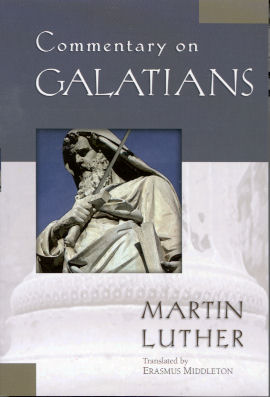
I have now read Dr. Luther’s commentary on the book of Galatians twice. The first time was for a seminary assignment. This winter, I read it again in preparation for a sermon series. Each time, I have been struck by the way in which Luther unpacks this wonderful epistle in such an easy-to-understand way. This is partly due to the translator’s intentional desire to make Luther “talk American.” In addition, Luther walks through Galatians verse by verse and even phrase by phrase. In so doing, the book takes on the nature of a series of devotions, focusing on the rich theology found in Galatians.
The commentary originates from a series of lectures given by Luther in 1531. When the book was finally put together and published in 1539, Luther wrote in the introduction, “In my heart reigns this one article, faith in my dear Lord Christ, the beginning, middle and end of whatever spiritual and divine thoughts I may have, whether by day or by night.” That quote accurately summarizes the theme that runs throughout the commentary. The Apostle Paul wrote Galatians because the people in the city of Galatia were being deceived by Jewish false teachers, saying that they needed to add their own good works to Christ’s work of justification. In this commentary, Luther fleshes out Paul’s clear teaching that righteousness before God comes by grace through faith alone in Christ’s finished work. Luther wrestles with Paul’s Old Testament references to Abraham, pointing out that this doctrine of faith alone is found throughout Scripture. Finally, I very much appreciated Luther’s discussion on Galatians 5 and the freedom that is found in the Gospel and the fruit that comes by abiding in Christ by faith alone.
Most commentaries would be difficult to recommend for general pleasure reading. Luther’s Commentary on Galatians is an exception. It has been translated and edited in an easy-to-read manner, and the structure and layout of the book lend itself to easy devotional reading. It is very reasonable to read only one or two pages at a time and find oneself tremendously blessed. Galatians is commonly understood as Luther’s favorite book of the Bible, and his commentary would be a wonderful resource for you this year in Bible study or daily personal devotions.
Pr. Micah Hjermstad
St. Paul's Free Lutheran Church
Fargo, ND
Order your copy here: Ambassador Publications Online Store
Also Available:
May 24, 2017
Martin Luther - DVD
Review by Pr. Ron Brubakken
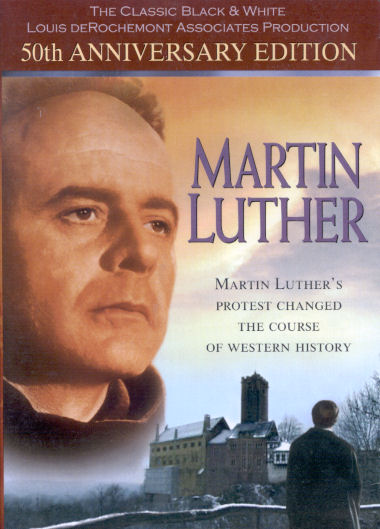
In viewing this black-and-white video production, I was provided with a view of Martin Luther asserting that the reason for Martin’s leaving law school was because of the climate of the times. The producers put forth the statement that the church introduced a period of legalism and judgment that induced fear in people and compelled the people to submit to the edicts and practices of the Roman Catholic Church. The movie portrayed Martin as being a problem monk, with the church questioning what to do with him. Rather than allow Martin to serve as a parish priest, they sent him to the academic world to study and teach. They also sent him on a journey to Rome to receive indulgences and relief from his time in purgatory. Martin, however, saw this as the church overstepping its authority and was bold enough to proclaim to his superiors that God’s righteousness comes from grace through faith, not by acts of man or the purchase of indulgences.
In his academic setting, Martin was provided the opportunity to delve into the Word, and in doing so, came to the realization of the truth presented in Romans 1:17—“For in the gospel a righteousness from God is revealed, a righteousness that is by faith from first to last, just as it is written: ‘The righteous will live by faith.’” Contrary to the practices of the Church and its leaders, Martin stood fast in his understanding of Sola Fide, and Sola Scriptura, Sola Christus, Sola Gratia, and Sola Deo Gloria.
The movie shows that Luther had many supporters, as well as those who desired that he be sanctioned and excommunicated. It also portrays the church as being more concerned with selling indulgences and relics. The stated goal was to build St. Peter’s Cathedral. Therefore, Johann Tetzel, on behalf of the church, began selling indulgences that he claimed removed for all time the need for repentance and granted forgiveness for as long as a person lived. Luther continued to search the Scriptures to find a source for the selling of indulgences and the practices of the church, but he was unable to find it supported in Scripture. The church then, seeking to have Luther’s writings destroyed and to remove him from influence, created a division that resulted in the Reformation.
This movie presents a slightly different take on Luther’s story and focuses on his stand against the misdeeds of the church and its grab for power over the people. It is a movie well worth considering and checking out from Ambassador Publications.
Pr. Ron Brubakken
Cornerstone Lutheran Church
Argyle, WI
Order your copy here: Ambassador Publications Online Store
This DVD and many others are available to check out from the Ambassador Publications Lending Library
Also Available:
May 31, 2017
The Martin Luther Story - DVD
from the Torchlighters Heroes of Faith series
Review by Pr. Dennis Norby
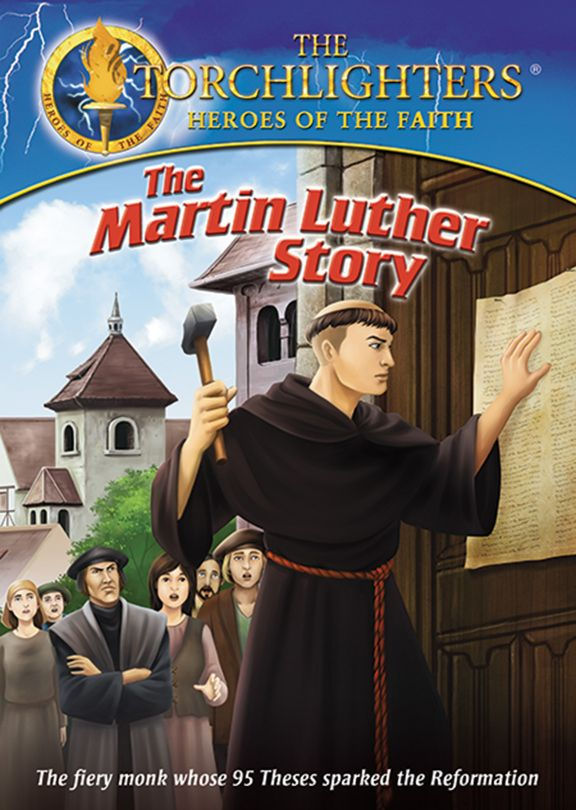
The Martin Luther Story is the fifteenth episode in The Torchlighters series produced by the Christian History Institute and The Voice of the Martyrs. This animated film spends nearly forty minutes portraying the life of Luther. This is a quick overview of Luther’s life from when he became a monk until his time in the Wartburg Castle translating the Bible into German.
The movie begins with the events which led Luther away from the study of law, to a monastery, and eventually into becoming a professor of the Scriptures in Wittenberg. As Luther studied the book of Romans, he grasped something which had previously caused him so much grief and sorrow. The righteousness of God is a gift given through faith in Christ. In the past, Luther had been deeply burdened by his lack of righteousness, but now he rejoices in Christ’s righteousness freely given to all who believe. The film makes clear that at the heart of his preaching and teaching Luther was pointing to the crucified and risen Christ.
Eventually, the nailing of the 95 Theses to the church door in Wittenberg and it’s quick printing and distribution cause many in Germany to rally behind the teaching of Luther. The actions of one little monk in Germany raise the concern of the Pope. This all culminates in the situation in Worms. At the Diet of Worms, Luther is asked to recant, and after being given time to sort through what he will say makes his famous “Here I stand” statement. He will not recant. The crowds rejoice at his steadfast confession. As Luther leaves he is taken captive and encouraged to write, specifically, to translate the Scriptures into German. As Luther translates, the animated recounting of Luther’s life ends, and a quick conclusion explains a few other items concerning Luther’s life.
The film was produced for children ages 8-12. As I watched this with my children (ages 1-12), they enjoyed the film, and it led them to ask a few questions. They asked about why Luther was talking in such a strange voice and why he looked different than the pictures of him they had seen. My daughters commented that they wanted to have Luther’s wife, Katherine Von Bora, in the film. Another comment I received was that it helped them understand why the Pope was upset with Luther during this time. As an introduction, this movie is well worth watching. It will give younger viewers a taste of Luther’s love for God’s Word and how God used him to bring about the Reformation.
Pr. Dennis Norby
Hope Lutheran Church
Enderlin, ND
Order your copy here: Ambassador Publications Online Store
Other Torchlighters DVDs are also available for purchase and can be borrowed from our Lending Library.
Also Available:
















